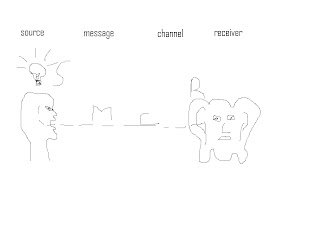Tuesday, May 31, 2011
Charting the Waters of Communication
Term Definition Mechanics Purpose
Communication | Idea transfer | Source, message, channel, receiver | Connection |
English | A collection of sounds and symbols agreed upon to communicate with | Vocabulary and Grammar | Communion—having a language in common |
Writing | Symbol manipulation | Stylus (and sometimes ink) and a medium | Clarity |
Sounds, symbols, letters
Humans have many senses beyond the five that are hardwired to actual organs (see, hear, smell, touch, taste). One of those is the sense of communication. Obviously, this particular sense has a lot to do with the hard-wired five as well. What you see is "communicated" to your brain where it triggers memories and often responses (positive, negative or otherwise). Hearing is a huge part of the mechanics of communication. Without a clear path of communication to the brain, how does one know what one smells is offensive or pleasant? Touch and taste communicate in very much the same way. Brain studies show us that the throat and intellect of the human appears actually "designed" for communication.
Another sense well-developed in the human psyche is the association of symbols with sounds and memories. This gives humans a visual short-hand for communicating ideas. In languages, these symbols have become role specific in that they represent particular sounds. In English, we call them letters. Saying and using letters follow particular patterns. For example, to say the letter "A" one must begin, hold it for a moment and then end. Aayyyeee (to exaggerate). This portends a basic quality of all communication: begin, hold, end. Take the word CAT---made up of the letters C--A--T. To communicate this word, one must start with the initial hard sound of "kuh." Then one must hold for a moment the medial sound of "Aa." Finally, one must end with the final sound of "tuh." Communication by it's nature has a beginning, middle and end.
Therefore, if one's goal is to get a message clearly across to another, they must keep this fact about each piece of communication in mind---it has a beginning, a middle and an end. How successful we are or how short we fall in communication depends on how well we follow this first rule (among others as our understanding expands).
Another sense well-developed in the human psyche is the association of symbols with sounds and memories. This gives humans a visual short-hand for communicating ideas. In languages, these symbols have become role specific in that they represent particular sounds. In English, we call them letters. Saying and using letters follow particular patterns. For example, to say the letter "A" one must begin, hold it for a moment and then end. Aayyyeee (to exaggerate). This portends a basic quality of all communication: begin, hold, end. Take the word CAT---made up of the letters C--A--T. To communicate this word, one must start with the initial hard sound of "kuh." Then one must hold for a moment the medial sound of "Aa." Finally, one must end with the final sound of "tuh." Communication by it's nature has a beginning, middle and end.
Therefore, if one's goal is to get a message clearly across to another, they must keep this fact about each piece of communication in mind---it has a beginning, a middle and an end. How successful we are or how short we fall in communication depends on how well we follow this first rule (among others as our understanding expands).
Friday, May 27, 2011
The Flow
sounds
letters
symbols
the symbolic nature of communication takes sounds we form and uses them to represent agreed upon variabes (letters)
ideas
words
ideation: nearly impossible to think the word "elephant" and not get a picture of one in your head
sentences
thoughts
the sentence is a complete unit of thought
paragraphs
arguments
the paragraph is the unit of construction for writers--a series of statements that begins with a proposition and ends with a conclusion
case
essay
story
the essay takes a series of arguments that support a case and arranges them in a pleasing manner with an overall introduction and an overall conclusion
letters
symbols
the symbolic nature of communication takes sounds we form and uses them to represent agreed upon variabes (letters)
ideas
words
ideation: nearly impossible to think the word "elephant" and not get a picture of one in your head
sentences
thoughts
the sentence is a complete unit of thought
paragraphs
arguments
the paragraph is the unit of construction for writers--a series of statements that begins with a proposition and ends with a conclusion
case
essay
story
the essay takes a series of arguments that support a case and arranges them in a pleasing manner with an overall introduction and an overall conclusion
Subscribe to:
Comments (Atom)
